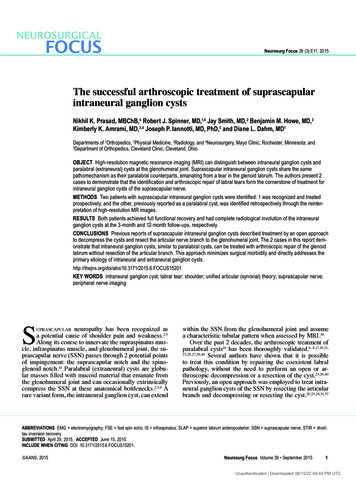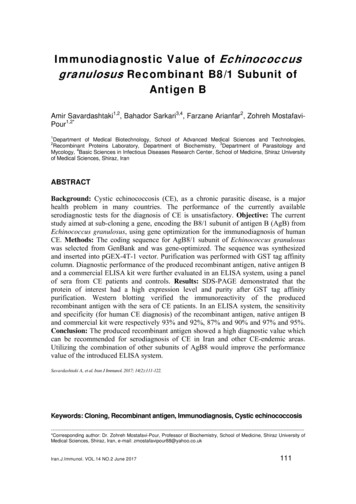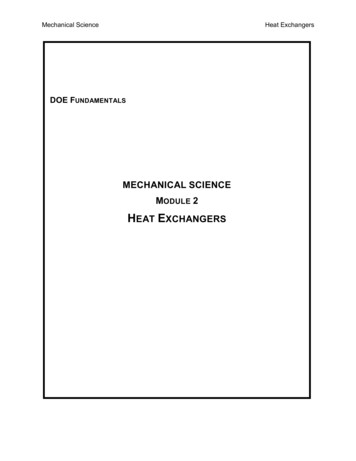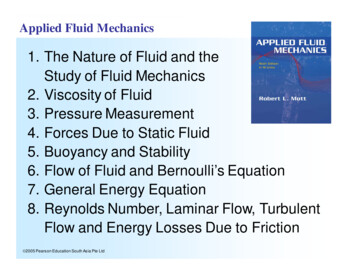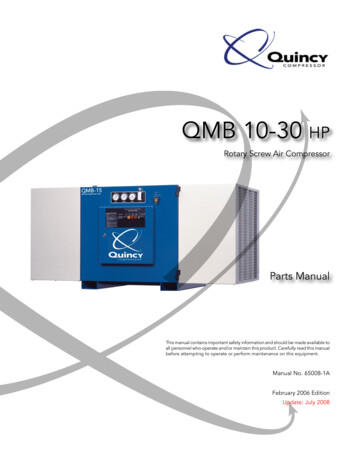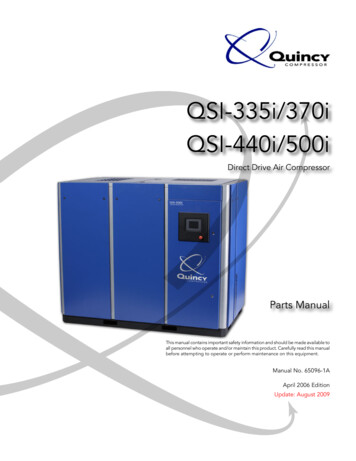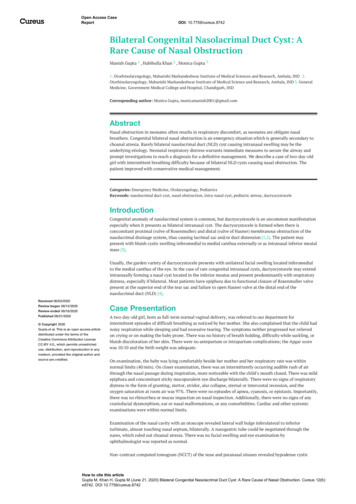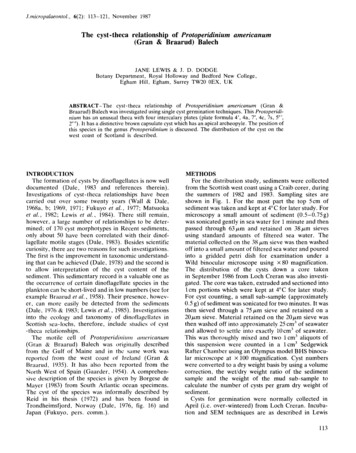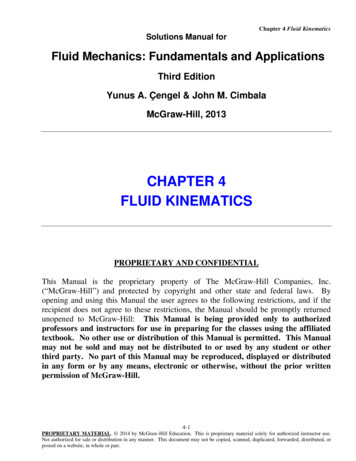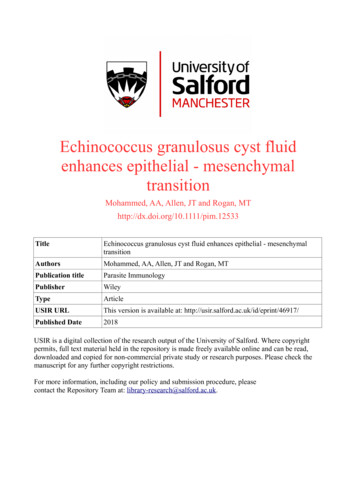
Transcription
Echinococcus granulosus cyst fluidenhances epithelial - mesenchymaltransitionMohammed, AA, Allen, JT and Rogan, ccus granulosus cyst fluid enhances epithelial - mesenchymaltransitionAuthorsMohammed, AA, Allen, JT and Rogan, MTPublication titleParasite ImmunologyPublisherWileyTypeArticleUSIR URLThis version is available at: d Date2018USIR is a digital collection of the research output of the University of Salford. Where copyrightpermits, full text material held in the repository is made freely available online and can be read,downloaded and copied for non-commercial private study or research purposes. Please check themanuscript for any further copyright restrictions.For more information, including our policy and submission procedure, pleasecontact the Repository Team at: library-research@salford.ac.uk.
Echinococcus granulosus cyst fluid enhances epithelial - mesenchymal transitionAhmed A. Mohammed*, J. Allen & M.T. Rogan†. Biomedical Research Centre,School of Environment & Life Sciences, University of Salford, M54WT, UK.*Current address: Branch of Clinical Laboratory Sciences, College of Pharmacy,University of Al-Mustansiriyah, Iraq.† Corresponding authorRunning title: E. granulosus cyst fibrosisACKNOWLEDGEMENTSThis work was funded through a PhD studentship from the Branch of ClinicalLaboratory Sciences, College of Pharmacy, University of Al-Mustansiriyah, Iraq.1
AbstractAimsCystic Echinococcosis is characterised by fluid filled hydatid cysts in the liver andlungs. The cysts are surrounded by a host fibrous layer (the pericyst) which acts toisolate the parasite from surrounding tissues. Previous studies in liver cysts haveindicated that the parasite may be stimulating fibrosis. The aim of this study was toinvestigate whether Hydatid Cyst Fluid (HCF) could influence the potential for fibrosisto occur in lung tissue by stimulating epithelial to mesenchymal transition (EMT) in ahuman lung epithelial cell line.Methods and ResultsAn adenocarcinoma-derived alveolar basal epithelial cell line (A549) was used as amodel for human alveolar epithelial cells (AEC II). These were cultured in vitro withHCF (UK sheep origin). Assays to investigate cell proliferation, cell migration andexpression of cytoskeletal markers showed that HCF could stimulate changes indicativeof EMT, including enhanced cell proliferation and migration; increased expression ofmesenchymal cytoskeletal markers (fibronectin and vimentin) accompanied by a downregulation of an epithelial marker (E-cadherin).ConclusionsMolecules within hydatid cyst fluid are capable of inducing phenotypic changes inA549 cells indicating that the parasite has the potential to modify lung epithelial cellswhich could contribute to fibrotic reactions.Key words: Echinococcosis; hydatid cyst; fibrosis; Epithelial – Mesenchymaltransition; A549 cell; pulmonary2
IntroductionCystic Echinococcosis (CE) is a zoonotic infection caused by the metacestode of thetapeworm Echinococcus granulosus and is characterised by the development of slowgrowing hydatid cysts, mainly in the liver and lungs of domestic livestock or humans.The typical hydatid cyst is a unilocular fluid filled chamber which, when fertile,contains the protoscoleces. The hydatid cyst fluid (HCF) is a complex biologicalmixture of various soluble components including glycolipids proteins, carbohydratesand salts and includes host molecules as well as parasite macromolecules (includingmajor diagnostic molecules, Antigen 5 (Ag5) and Antigen B (AgB) (1-3). The fluid issurrounded by a cyst wall of three layers, the inner germinal layer which in turn isenclosed by an acellular laminated layer and surrounded by a fibrous outer layer(referred to as either the adventitial layer or pericyst) which is of host origin (4-7).The host-parasite relationship in Cystic Echinococcosis is extremely complex and cystsurvival, growth and development is dependent on a balance between hostimmunological activity from one side, and the expression of parasite immunoevasivestrategies from the other (5,8-10). The fibrotic host response around the cyst is part ofthis relationship and the relative thickness of this layer can vary depending on theanatomical location of the cyst. In general, within animal hosts, it is most developed inhepatic cysts and to a lesser extent in lung cysts (11-13). It has also been suggested thatthis fibrotic activity may help in restricting growth of the cysts with lung cysts beingperceived as having a higher growth rate than hepatic cysts (13). This suggestion is alsosupported in rare cases of brain cysts where there is little fibrosis and where very highgrowth rates have been estimated (14).Whilst the fibrous pericyst is clearly amechanism by which the host is attempting to isolate the parasite and restrict itsdevelopment, it could also conceivably be a mechanism which is protective to theparasite, acting as a further barrier to potentially damaging immune effectormechanisms. (15-16)In hepatic Echinococcosis (CE and AE) the parasites are known to both upregulate anddown regulate several hundred host genes associated with metabolism, the immunesystem (complement cascade and antigen processing) and cell signaling and transport.(17-20) and it has recently been shown that HCF from E. granulosus may promotefibrosis in hepatic stellate cells by down regulation of miR-19B (21). Similar studies3
have not been carried out in relation to lung tissue where it might be expected thatfibrogenic activity would be reduced. Indeed, cellular pathology and immunoregulationof pulmonary CE has been somewhat neglected.Fibrogenesis and deposition of collagen can be initiated and regulated in differenttissues by different mechanisms. In the lungs, one such mechanism involves alveolarepithelial cells (AECII) which, under certain conditions, can undergo an epithelial tomesenchymal transition (EMT), i.e. the transformation of the epithelial cells tomesenchymal cells with a myofibroblast-like phenotype with subsequent hyperplasiathat is pathognomonic for human lung fibrosis with subsequent collagen deposition (22,23). Epithelial cells which undergo EMT reorganize their cytoskeleton (23, 24) andacquire increased migratory characteristics (25, 26), accompanied by down-regulationof epithelial differentiation markers including E-cadherin and cytokeratin, andtranscriptional induction of mesenchymal markers such as vimentin, fibronectin and Ncadherin (24, 26-30).Parasite induced initiation of fibrogenesis in liver tissue is likely to involve a range ofcells such as macrophages and hepatic stellate cells but there is currently no informationon how the parasite can modify lung tissue. In order to establish whether metacestodesof E. granulosus are actively involved in altering the environment within the lungsleading to possible fibrosis, the A549 lung epithelial cell line was used to investigateEMT-like changes resulting from exposure to parasite-derived molecules present inHCF. A549 are often used in initial studies as a model for investigating effects onhuman alveolar epithelial cells type II (AECII) because they demonstrate many of theproperties of normal lung AEC(31,32), particularly their metabolic, structural andtransport characteristics (25). Previous investigations into lung EMT have made use ofthis cell line and have shown it to exhibit EMT-like responses which are similar to thoseobtained with normal alveolar epithelial cells.Materials and methodsHydatid Cyst Fluid (HCF) samples4
Samples of HCF were obtained from fertile cysts in individual naturally infected sheepfrom UK abattoirs. All samples were filter sterilized and stored frozen at -20oC untiluse. The condition of each batch of cyst fluid was assessed by checking the relativeantigenicity of samples from different sheep by ELISA against sera from human CEcases and the six highest reacting samples were pooled together for use in the cellculture experiments (data not shown). The protein concentration of the pooled HCFsample was estimated using a colourimetric assay (Biorad) to be 0.18mg/ml. Allsamples were checked to be free from the presence of bacterial endotoxins using theToxinSensorTM Chromogenic LAL Endotoxin Assay Kit (GenScript).Cell proliferation assay.A549 cells (Sigma Aldrich) were seeded at a density of 5 104 cells per well in 6 wellplates (Falcon) and maintained in RPMI-1640 medium (Labtech International)supplemented with 10% foetal bovine serum FBS (Fisher Scientific), 1% L-Glutamine(Lonza) and 1% Penicillin-Streptomycin-Amphotericin B (Lonza), termed completemedium (CM). For experiments, cells were changed to serum limited medium (LSM)containing 0.5% FBS. Cell number and FBS concentration were optimised prior tofinalising culture conditions (see Supplementary Data, Figs i and ii). Cells wereincubated in 37 C incubator (Sanyo-Japan) in a humidified 5% CO2 atmosphere.Pooled HCF (initial concentration of 0.18mg/mL protein) was diluted 1 in 10 (18 g/mL), 1 in 20 (9 g/mL), 1 in 50 (3.6 g/mL) and 1 in 100 (1.8 g/mL) in LSM andadded to the plates. Cells were incubated for 120 hours with one medium change after72 hours. Cell growth from three replicate wells was estimated on each day using directmicroscopic examination and a cell proliferation assessment where cell numbers weredetermined by crystal violet staining according to Chiba et al. (33). Briefly, wells werewashed 2 times with PBS and stained with 1ml 0.1% Crystal Violet (CV) for 15 minutesat room temperature. The stain solution was aspirated and wells washed 3 times withdH2O before being allowed to air dry. 1 mL of methanol was then added to each wellto extract the dye taken up by living cells. After 15 minutes, 100μL was transferred toa 96 well microtitre plate and absorbance was measured at 620nm in an AscentMultiscan reader (Thermo Scientific). A calibration curve was used to relate opticaldensity to estimated cell number.5
Cell migration assay.Cell migration was assessed using a wound healing assay according to Liang et al. (34)with minor modifications. Cells were cultured in CM as described above until 70%confluent, then washed in LSM before a longitudinal scratch (wound) was made in themiddle of each well using a 100µL pipette tip. HCF (18 g/mL) in LSM, or LSM alonewas applied as a treatment. Cells were examined after 24 hours and 48 hours on aninverted microscope and the distance between the two sides of wound was measured atfive equidistant points along the wound, (0.6mm between each point).EMTTo investigate expression of EMT markers, sub-confluent A549 cells were treated witheither 10% HCF (final protein concentration 0.18mg/mL) in LSM, or with 5ng/mLTGF-β1 (PeproTech-USA) in LSM, as a known inducer of EMT (35), or LSM alone.Cells were cultured for a further 3 days before immunocytochemistry and microscopicexamination. Cells were washed 2 times in PBS, fixed for 5 mins with 4% formaldehyde(Sigma-Aldrich), washed 2 times in PBS, then permeabilised by 1% Triton X-100(Sigma-Aldrich) for 5 minutes (for E-cadherin) and 0.5% Triton X-100 for 10 mins(Cytokeratin, Fibronectin and Vimentin), followed by 3 washes for 5 minutes with PBS.Non-specific binding was blocked with 3% BSA (Sigma-Aldrich) for 1 hour at roomtemperature and then cells were exposed to 1:1000 dilution (in PBS plus 1% BSA) ofeither: mouse anti-human E-cadherin (Clone HECD-1, Takara, Japan); mouse antihuman pan cytokeratin (clone C-11, Abcam, UK); mouse anti-human fibronectin (cloneIST-9 Abcam, UK); or mouse anti-human vimentin (Sigma-Aldrich) and incubatedovernight at 4 C in a wet tray. The next day, cells were washed 3 times in PBS, andincubated for 2 hours in the dark at room temperature with 1:2000 Alexa Fluor 546 goatanti-mouse IgG (Life Technologies-USA) in PBS plus 1% BSA. Cells were finallywashed 3 times in PBS and mounted in 10µL mounting medium containing DAPI(Thermo Fisher Scientific) to stain cell nuclei for 1 hour. Wells were examined usingan Eclipse TE2000-S microscope system (Nikon UK Ltd, Surrey) and Image-Pro Plus(Media Cybernetics UK, Berkshire).Semi-quantification of EMT marker expression was carried out by analysis of imagesat six fields in each well under the same image exposure conditions. The position offields was chosen from a pre-defined grid pattern determined for all slides using the x6
y co-ordinates on the microscope stage. Cells were counted within each field, and thepercentage of positively labelled cells (cells expressing a certain marker) calculated foreach group. Two patterns of distribution within individual cells were sometimes evidentand were defined as either extensive (E), throughout the whole cytoplasm or condensed(C) in small areas in the perinuclear region. Where these patterns were evident, theproportion of cells showing each pattern was also determined.Statistical analysesFor the cell proliferation and cell migration studies results are presented as mean valuesfor three replicate wells in each treatment. Data was analysed using a paired t-testcomparing treated and controls at each time point and for the cell proliferation study aone way ANOVA was also performed (IBM SPSS Statistics 20).Each assay wasrepeated three times and similar trends were seen in all three occasions. For the cellmarker studies counts were taken at six points in each well for three replicate wells. Aone way ANOVA was carried out for all treatments and all markers and also to compareall markers between HCF treated and control slides, and between HCF treated and TGFβ1 treated cells. In all cases values of p 0.05 were considered statistically significant.ResultsCell proliferationThere were no significant differences in proliferation between HCF treated cells andcontrols over the first 72 hours. However, from 3 to 5 days of culture there was a dosedependent increase in proliferation observed with HCF (Fig. 1) compared to controls(p 0.001) with the highest concentration of HCF resulting in a 250% increase in cellnumber.Cell migrationSemi-quantitative analysis of scratch assay plates showed an enhanced cell migrationin the presence of HCF compared to control. At 24 hours, HCF-treated cells (Fig. 2A)7
had migrated further into the “scratch” than control cells in some areas but the meangap between each side of the “scratch” was not significantly different from controls(Fig 2B, p 0.05). However, at 48 hours the gap between the sides of the wound wasclosed in many areas of the HCF treated cells and the mean gap was significantlysmaller compared to controls (Fig. 2B, p 0.05).EMTEpithelial markers (Fig. 3): cells treated with HCF showed downregulation of Ecadherin (E-Cad) expression with 40.8% positive for E-Cad in HCF treated cells,compared to 76.1% in controls (p 0.01). By comparison, TGF-β1 as a known EMTinducer completely inhibited expression of E-Cad (Fig. 3A). Cytokeratin wasubiquitously expressed and there were no significant differences between treated andcontrol cultures (Fig. 3B). With respect to the intracellular distribution of expression,the ‘extensive’ pattern is more typical of an epithelial phenotype and although HCFtreated cultures appeared to demonstrate fewer cells with this distribution pattern, Thedifferences in numbers did not reach significance, compared to those found in thecontrol cultures (p 0.05). It was also noted that the staining intensity of the HCFtreated cells was less than controls but this was not quantified. TGF- 1 also did notreduce cytokeratin expression and had a similar pattern of staining to controls.Mesenchymal markers (Fig 4): cells treated with HCF showed upregulation offibronectin (Fn) expression with 39.6% positive for Fn in HCF treated cells, comparedto just 13% in controls (p 0.01) which only weakly expressed this marker. Incomparison, cells treated with TGF-β1 also upregulated Fn expression with 51.7%positive cells. Importantly, Fn expression in TGF-β1-treated cells was not statisticallydifferent to Fn expression in HCF treated cells, (p 0.05). The number of cells positivefor Vimentin (Vm) was not significantly different between HCF treated and controlcultures (Fig. 4B), although the distribution of the marker varied. In control cellsvirtually all vimentin expression was limited to ‘condensed‘ areas in the perinuclearregion. However, in HCF and TGF-β1 treated cultures significantly more cells showedmore ‘extensive’ marker distribution throughout the cytoplasm (p 0.01). Howeverexpression in TGF-β1 treated cells was significantly greater than in HCF treated cells(p 0.05). In addition to mesenchymal marker expression, it was noted that some cells8
in HCF treated cultures also displayed morphological features consistent with amesenchymal phenotype, in producing extended cytoplasmic processes (Fig 4B).Statistical analysis by ANOVA indicated when all treatments and all markers werecompared, significant differences were evident (p 0.01). The ANOVA comparingHCF treated cells to controls for all markers showed significant differences (p 0.05)but the differences between HCF treated cells and TGF-β1 treated cells was alsosignificant (p 0.05).DiscussionThe results of this study indicate that HCF can affect A549 cells by increasing theirproliferation and migratory activity. In addition, exposure to HCF also alters theexpression of some phenotypic markers i.e down regulation of epithelial markers suchas E-cadherin and upregulation of mesenchymal markers such as fibronectin andvimentin. Although HCF treatment modified expression of some markers its effectswere different from TGF-β1, a known initiator of EMT, mainly in relation to the levelof regulation. It is also interesting to note that both treatments did not affect cytokeratinexpression. Recent investigations note that EMT is not a binary process and cells candisplay a range of hybrid states that include but are not limited to, fully epithelial andfully mesenchymal, and in fact a hybrid partial EMT phenotype with cells coexpressing markers of both epithelial and mesenchymal states has been suggested to bea stable phenotype that cells can adopt, depending on external factors (36).Taken together, these alterations are supportive of HCF-mediated induction of EMT.Although there was no significant effect on cytokeratin expression, vimentin expressionwas considered to be more extensive throughout cells, a feature which is associatedwith mesenchymal cytoskeletal reorganisation (37). These effects on A549 cells inthemselves are not indicative of a full fibrotic reaction which would involve monitoringcollagen deposition and other elements such as - smooth muscle actin ( SMA), butdo indicate that parasite derived molecules can lead to transformations in host cellswhich make fibrogenesis in lung tissue more likely. EMT is a frequent feature inpatients with lung fibrosis caused by other factors. Hydatid cyst fluid from E.granulosus is known to have significant effects on a variety of host immune cells, fromacting as a mitogen, non-specifically stimulating lymphocyte proliferation (38), to9
altering accessory cell function and antigen processing (39). It has also been shown tomodify the phenotype of cells such as monocytes (40). In most cases these effects aregenerally believed to influence the nature of the immune response in favour of parasitesurvival and often linked to a more permissive Th2 type response (8,9, 4, 42). Howeverthere have been no studies which have indicated that the phenotype of epithelial cellscan be modified by HCF. The findings from this study in a lung cell line are supportiveof the findings in LX-2 hepatic stellate cells (21) where HCF from E. granulosus hasbeen shown to increase expression of α-SMA, COL1A1 and COL3A1 along withincreased TβRII expression and inhibition of miR-19b. These authors interpretation isthat E. granulosus metacestodes may actively promote fibrosis through the increase inTβRII, the activation of hepatic stellate cells and extracellular matrix production.It may be argued that the concentration of HCF used in these studies (18 g/mL) is inexcess of the true in vivo situation. HCF does leak out in large amounts, of cysts whichhave been damaged and may lead to anaphylactic reactions (43). However there are nodefinitive studies which have looked at release of cyst fluid from intact cysts. But it isknown that antibodies to major cyst fluid antigens are present in most CE patients andthat antibody levels may fluctuate within individuals indicating periodic release ofantigen. Circulating cyst fluid antigens are also detectable in some CE patients (44). Itshould also be noted that HCF is a complex mixture of both host and parasite moleculesand that the total protein concentration used in these studies will reflect all moleculespresent. The active molecules responsible for the observed effects are therefore likelyto be present at much smaller concentrations.In the current study it is evident that there is a mechanism by which cyst fluidcomponents derived from lung hydatid cysts could also promote fibrosis via EMT ofAECII cells and subsequent differentiation into myofibroblasts. Such events wouldsuggest that fibrosis is potentially beneficial for the parasite by actively stimulating thebuilding of fibrous layers. The parasite recruits host cells to migrate toward the parasitelesion and stimulates their proliferation and transition to the fibroblast-like phenotypewhich subsequently deposits ECM components.10
The exact molecules involved in transitional events are not known. It is valid to questionwhether or not host components may be responsible for the observed cellular changesin A549 cells but it is important to remember that the cell line is of human origin whilstthe HCF will contain host molecules which are of sheep origin. In addition, proteomicanalysis of HCF has not shown the presence of known cytokines (2, 45). Additionalstudies also indicate that HCF is not simply acting as a source of nutritional protein asthe same proliferative effects were not evident when HCF was substituted with bovineserum albumen (BSA) at the same concentration. (See Supplementary Data, Fig iii).The mechanism by which HCF induces EMT is also not known. Direct stimulation ofthe cells via a ligand/receptor interaction may be possible but initiation of autocrinesecretion of TGF-β may also be possible. With E. multilocularis infections in micechronic hepatic fibrosis is a classical feature of the infection and acts to both isolate theparasite and contributes to pathology. TGF- / Smad interactions are thought to be thedriving mechanism of this process in hepatic cells, with TGF- being produced as aresult of either parasite induced inflammation or potentially by parasite derivedmolecules which can interact with the T RI or T RII receptor (19). It is known thatHCF contains many parasite molecules, some of which have cytokine-like properties,but it is interesting to note that the proliferative and migratory responses observed inthis study were retained after heating the cyst fluid to 95oC for 5 minutes, a process thatwould affect the structural integrity of typical mammalian cytokines. Similar activitywas also evident in a semi-purified extract of Antigen B indicating that this known,heat-stable immunomodulatory molecule may have a role. (see Supplementary Data,Figs iv and v).Extensive fibrosis and pericyst formation in CE is often seen as a mechanism by whichthe host restricts the growth and proliferation of the metacestode. Conversley recentstudies in experimental mice have shown that IL-17A can reduce fibrosis which leadsto a reduced parasite biomass (46) indicating that a fibrotic reaction is favourable to theparasite. The thick pericyst, in addition to acting as a barrier, also provides considerablemechanical strength to the fluid filled cyst which may be under considerable hydrostaticpressure. From a transmission perspective it is important that cyst integrity ismaintained in the natural intermediate host (domestic/wild livestock) to be available to11
carnivorous canids. The fibrotic pericyst may therefore be essential to prevent cystdegeneration within the internal organs of dead livestock. This could be particularlyimportant in lung cysts where the surrounding pulmonary tissue is less rigid.12
References1. Larrieu EJ, Frider B. Human cystic echinococcosis: contributions to the naturalhistory of the disease. Ann Trop Med & Parasitol. 2001; 95: 679-687.2. Aziz A, Zhang W, Li J, Loukas A, McManus DP, Mulvenna J. Proteomiccharacterisation of Echinococcus granulosus hydatid cyst fluid from sheep, cattle andhumans. J Proteomics 2011; 74: 1560-1572.3. Li ZJ, Wei Z. Analysis of Protoscoleces-specific Antigens from Echinococcusgranulosus with Proteomics Combined with Western Blot. Biomed Environ Sci 2012;25:718-7234. Rogan MT, Hai WY, Richardson R, Zeyhle E, Craig PS. Hydatid cysts: does everypicture tell a story? Trends Parasitol. 2006; 431-8.5. Vuitton DA. The ambiguous role of immunity in echinococcosis: protection of thehost or of the parasite? Acta Tropica 2003; 85: 119-132.6. Díaz A, Casaravilla C, Irigoín F, Lin G, Previato JO, Ferreira F. Understanding thelaminated layer of larval Echinococcus I: structure. Trends Parasitol; 27: 204-213.7. Golzari SEJ, Sokouti M. Pericyst: The outermost layer of hydatid cyst. World JGastroenterol : 2014; 20: 1377-1378.8. Siracusano A, Delunardo F, Teggi, A., et al. Host-parasite relationship in cysticechinococcosis: an evolving story. Clin Dev Immunol. 2012; 6393629. Wang J, Gottstein B. Immunoregulation in larval Echinococcus multilocularisinfection. Parasite Immunol 2016; 38: 182-19210. Brehm K, Koziol U. Echinococcus-Host Interactions at Cellular and MolecularLevels. Adv Parasitol 2017. 95; 147-21211. Njoroge EM, Mbithi PM, Gathuma JM, et al. Study of cystic echinococcosis inslaughter animals in three selected areas of northern Turkana, Kenya. Vet Parasitol2002. 104: 85–9113
12. Beigh AB, Darzi, MM, Bashir, S et al. Gross and histopathological alterationsassociated with cystic echinococcosis in small ruminants J Parasit Dis. 2017 41: 1028.13. Barnes TS, Hinds LA, Jenkins DJ, Bielefeldt-Ohmann H, Lightowlers MW,Coleman GT Comparative Pathology of Pulmonary Hydatid Cysts in Macropods andSheep. J Comp Pathol 2011. 144: 113-12214. Valour F, Khenifer S, Della-Schiava N et al. Unusual growth rate during cysticechinococcosis. Parasitol Int. 2014; 63: 275-277.15. Rogan MT, Craig, PS. Immunology of Echinococcus granulosus infections, ActaTropica 1997; 67:7-1716. Peng XY, Wu XW, Zhang SJ, Niu JH. The new aspects in recognition ofpathogenesis of the pericyst of human hepatic Echinococcus granulosus. World Chin JDigestol. 2005. 13: 276–917. Gottstein B, Wittwer M, Schild M et al. Hepatic gene expression profile in miceperorally infected with Echinococcus multilocularis eggs. PLoS One 2010. 5; e977918. Lin R, Lü G, Wang J et al. Time Course of Gene Expression Profiling in the Liverof Experimental Mice Infected with Echinococcus multilocularis. PLoS One 2011; 6:e14557.19. Wang J, Zhang C, Wei, X, et al. TGF-beta and TGF-beta/Smad Signaling in theinteractions between Echinococcus multilocularis and its hosts. PLoS One 2013. 8:e5537920. Hui W, Jiang S, Liu X, Ban Q, Chen S and Jia B. Gene Expression Profile in theLiver of Sheep Infected with Cystic Echinococcosis. PLoS One 2016; 11: e0160000.21. Zhang C, Wang L, Ali T et al. Hydatid cyst fluid promotes peri-cystic fibrosis incystic echinococcosis by suppressing miR-19 expression. Parasit Vectors 2016; 9: 278.22. Pirozzi G, Tirino V, Camerlingo R et al. Epithelial to Mesenchymal Transition byTGFβ-1 Induction Increases Stemness Characteristics in Primary Non Small Cell LungCancer Cell Line. PLoS One 2011; 6: e21548.14
23. Ramos C, Becerril C, Montano M et al. FGF-1 reverts epithelial-mesenchymaltransition induced by TGF-b1 through MAPK/ERK kinase pathway. Am J PhysiolLung Cell Mol Physiol 2010; 299: L222-231.24. Shintani Y, Okimura A, Sato K et al. Epithelial to Mesenchymal Transition Is aDeterminant of Sensitivity to Chemoradiotherapy in Non-Small Cell Lung Cancer. AnnThorac Surg 2011; 92: 1794-1804.25. Mikami Y, Yamauchi Y, Horie M et al. Tumor necrosis factor superfamily memberLIGHT induces epithelial–mesenchymal transition in A549 human alveolar epithelialcells. Biochem Biophys Res Commun 2012. 428: 451-457.26. Suh SS, Yoo JY, Cui R et al. FHIT Suppresses Epithelial-Mesenchymal Transition(EMT) and Metastasis in Lung Cancer through Modulation of MicroRNAs. PLoSGenetics 2014; 10: e1004652.27. Kalluri R, Neilson E G. Epithelial-mesenchymal transition and its implications forfibrosis. J Clin Invest 2003, 112: 1776-1784.28. Pozharskaya V, Torres-Gonzalez E, Rojas M et al. Twist: a regulator of epithelialmesenchymal transition in lung fibrosis. PLoS One 2009; 4: e7559.29. Corbiere V, Dirix V, Norrenberg S, Cappello M, Remmelink M and Mascart F.Phenotypic characteristics of human type II alveolar epithelial cells suitable for antigenpresentation to T lymphocytes. Respir Res 2011; 12: 15.30. Sueki A, Matsuda K, Iwashita C et al. Epithelial–mesenchymal transition of A549cells is enhanced by co-cultured with THP-1 macrophages under hypoxic conditions.Biochem Biophys Res Commun 2014; 453: 804-809.31. Barkauskas CE, Noble PW. Cellular Mechanisms of Tissue Fibrosis. 7. Newinsights into the cellular mechanisms of pulmonary fibrosis Am J Physiol Cell Physiol.2014. 306: C987-C99632. Kawami M; Deguchi J; Yumoto R, et al. Effect of COA-Cl on transforming growthfactor-beta 1-induced epithelialemesenchymal transition in RLE/Abca3 cells DrugMetab Pharmacokinet 2017. 32: 224-22715
33. Chiba K, Kawakami K, Tohyama K. Simultaneous evaluation of cell viability byneutral red, MTT and crystal violet staining assays of the same cells. Toxicol In Vitro1998; 12: 251-258.34. Liang CC, Park AY and Guan JL. In vitro scratch assay: a co
plates (Falcon) and maintained in RPMI-1640 medium (Labtech International) supplemented with 10% foetal bovine serum FBS (Fisher Scientific), 1% L-Glutamine (Lonza) and 1% Penicillin-Streptomycin-Amphotericin B (Lonza), termed complete medium (CM). . overnight at 4 C in a wet tray. The next day, cells were washed 3 times in PBS, and
